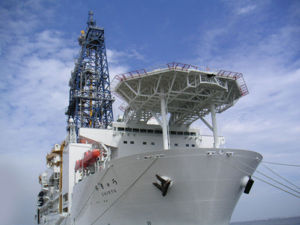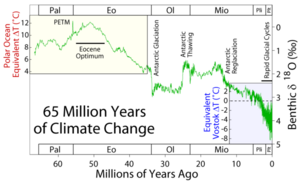
Behaviour of the Earth System during Major Events
According to earlier understanding of Earth System history, derived from records in marine sedimentary rocks, it seems that long periods of relative stasis were interrupted by occasional sharp transitions to a new environmental state. This earlier view of stasis may partly reflect the (lack of) resolution of earlier sedimentary records. As scientists have obtained more finely-resolved records with a closer spacing of data points in time then increasing variability has been revealed. This is also the case for the last few hundred thousand years, during which time the closely-spaced points from the ice-core record reveal many more episodes of abrupt climate change than were apparent in the earlier records obtained from drilling through ancient seabeds.
Despite issues of how well the available data records can reveal variability, it is nevertheless apparent that there have been occasions when the Earth System has changed rather rapidly or has undergone a sudden large perturbation such as in response to a comet impact. The behaviour of the Earth System during these perturbations or transitions, and also during the subsequent recovery, is of distinct interest. The responses to large-scale upheavals may be especially revealing as to how the Earth System works.
Many hypotheses have been put forward to explain what happened to the Earth during these events and the mechanisms underpinning subsequent recovery. Some of these hypotheses have been tested using simple biogeochemical models such as the JModels. Sometimes the models support the proposed explanation, but other times there are glaring inconsistencies. The Jmodels can be used to quantitatively test competing hypotheses and in some cases disprove them. The Jmodels can be used to explore, among others, the following events:
(a) greenhouse-icehouse transition: at the Eocene-Oligocene boundary (ca. 34 Mya) new polar ice sheets formed, after many tens of millions of years during which the Earth had none. There was also an unprecedented and permanent change to ocean carbon cycling. Several explanations have been put forward as to how the two might be linked.
Climate change over the last 65 million years.This image is an original work created for Global Warming Art.
(b) ocean acidification event: at the Paleocene-Eocene boundary (ca. 55 Mya) the world experienced several sharp changes including global warming and dissolution of calcium carbonate indicating ocean acidification. This event may be the closest analogue in the palaeo record for the ongoing human-associated changes.
(c) Diatom event: an event christened the "Silica Burp" occurred ca. 50 Mya. Marine sediments from this time show a greater abundance of biogenic silica than at any other time during the Cenozoic era.
(d) Snowball Earth: the Earth became completely or almost completely covered in ice during several events during the period 850-630 Mya. But in all the intervening time since, while large-scale glaciation has occurred many times there have never been any subsequent snowballs. Could this be due to the arrival of the carbonate compensation feedback?
(e) anoxic oceans: in contrast to today’s ocean in which oxygen is almost everywhere present, during past Oceanic Anoxic Events (e.g. ca. 120 and 93 Mya) the deep ocean became almost everywhere depleted in oxygen. Because low oxygen conditions promote fixed nitrogen destruction, nitrogen cycling must have been distinctly different from today.
